Geology and geomorohology of Upper Agri Valleyby Antonio Priore
Beginning the knowledge of geological and natural aspects of the territory helps the comprehension of the main causes that led the man, in antiquity as today, to explore and then “take possession” of new areas. The morphological shape, geographical characteristics and energy resources available here made it possible the settlement of various human communities in Upper Agri Valley during different prehistoric and historical periods, and developing over the centuries, created the current set of the valley. Human impact in Agri Valley had an important acceleration in the last hundred years, when have been interventions with substantial engineering works especially along Agri fluvial axis, embanking the river and creating a large dam (150 million cubic meters) that collects and guarantee still now, by Lago di Pietra del Pertusillo, sizeable quantities of water during periods of low water. Despite these massive interventions, it’s still possible to read, inside geology and geomorphology of the territory, the reasons that induced humans to choose it as area of great interest for settlement and soil depletion.
|





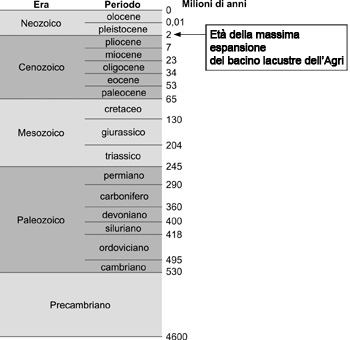 Chronological setting: the geologic time
Chronological setting: the geologic time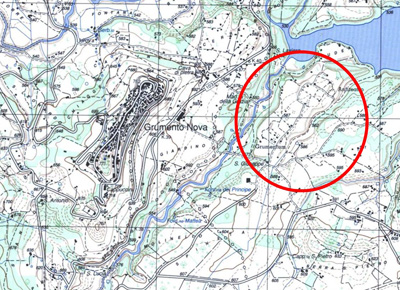 In this way Giuseppe De Lorenzo, geologist from Lagonegro lived between 1800 and 1900, described the upper Agri Valley, during his travels in places used to be sites of ancient lakes.
In this way Giuseppe De Lorenzo, geologist from Lagonegro lived between 1800 and 1900, described the upper Agri Valley, during his travels in places used to be sites of ancient lakes.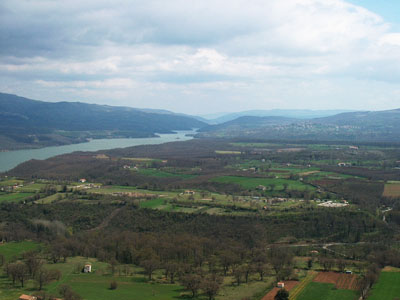
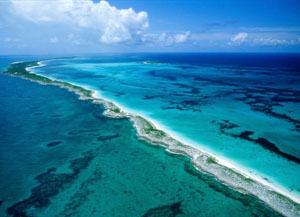 Afterwards, in
Afterwards, in 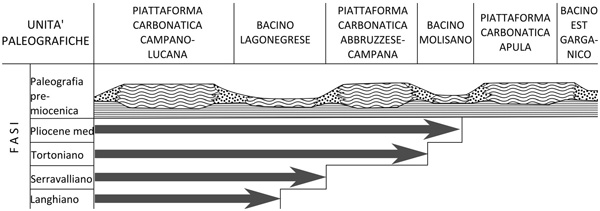

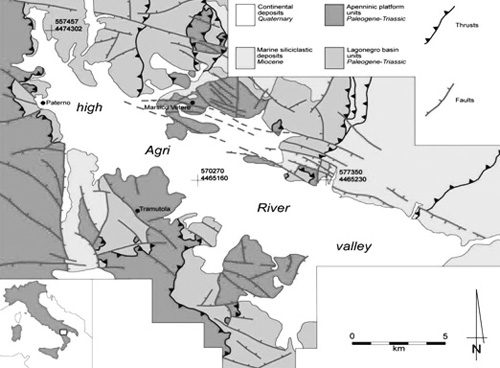 The sedimentary sequence of Upper Agri Valley Basin can be summarized into three main sedimentary successions: a basal interval mainly made up of pelitic levels, and two subsequent intervals fed by sandy-pebbly-conglomeratic contributions resulting from erosive dismantling of the surrounding mountains.
The sedimentary sequence of Upper Agri Valley Basin can be summarized into three main sedimentary successions: a basal interval mainly made up of pelitic levels, and two subsequent intervals fed by sandy-pebbly-conglomeratic contributions resulting from erosive dismantling of the surrounding mountains.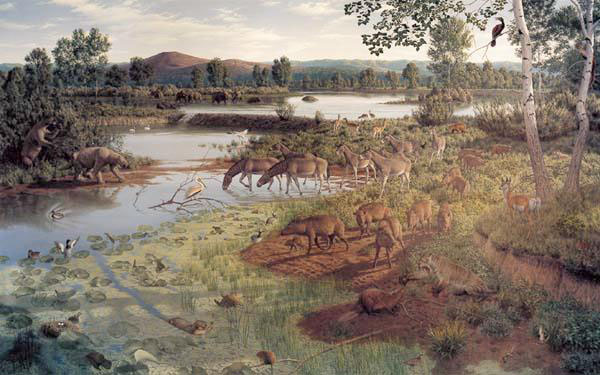
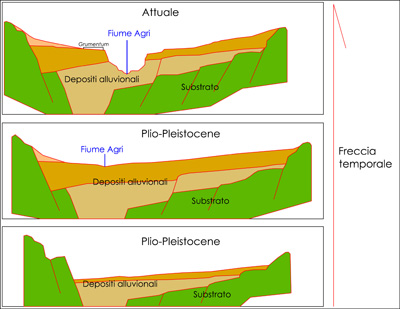 The plain, subject to phenomena of flooding and out-and-out phases of flood during Roman era, didn’t have many areas suitable for the presence of man; most of the areas upstream of the main site in fact could be imagined flooded, marshy or swampy. Grumentum area, on the other side, despite being located in the plain, had the protection of morphological terrace, high even dozen of meters on the level of the torrents Sciaura on the west, Maglie on the east and the same Agri on the north, and most of all it was located far away from unhealthy areas. The favorable location allowed the inhabitants of the area to develop an urban fabric without any hydrogeological and geological conditioning, enjoying a natural protective barrier, considering that the slopes surrounding the area are also quite steep. The soils well-developed and rich of pyroclastic contributions situated in depth over the valley allowed also to develop specialized cultivations and facilitated the setting of timber tree woods.
The plain, subject to phenomena of flooding and out-and-out phases of flood during Roman era, didn’t have many areas suitable for the presence of man; most of the areas upstream of the main site in fact could be imagined flooded, marshy or swampy. Grumentum area, on the other side, despite being located in the plain, had the protection of morphological terrace, high even dozen of meters on the level of the torrents Sciaura on the west, Maglie on the east and the same Agri on the north, and most of all it was located far away from unhealthy areas. The favorable location allowed the inhabitants of the area to develop an urban fabric without any hydrogeological and geological conditioning, enjoying a natural protective barrier, considering that the slopes surrounding the area are also quite steep. The soils well-developed and rich of pyroclastic contributions situated in depth over the valley allowed also to develop specialized cultivations and facilitated the setting of timber tree woods.